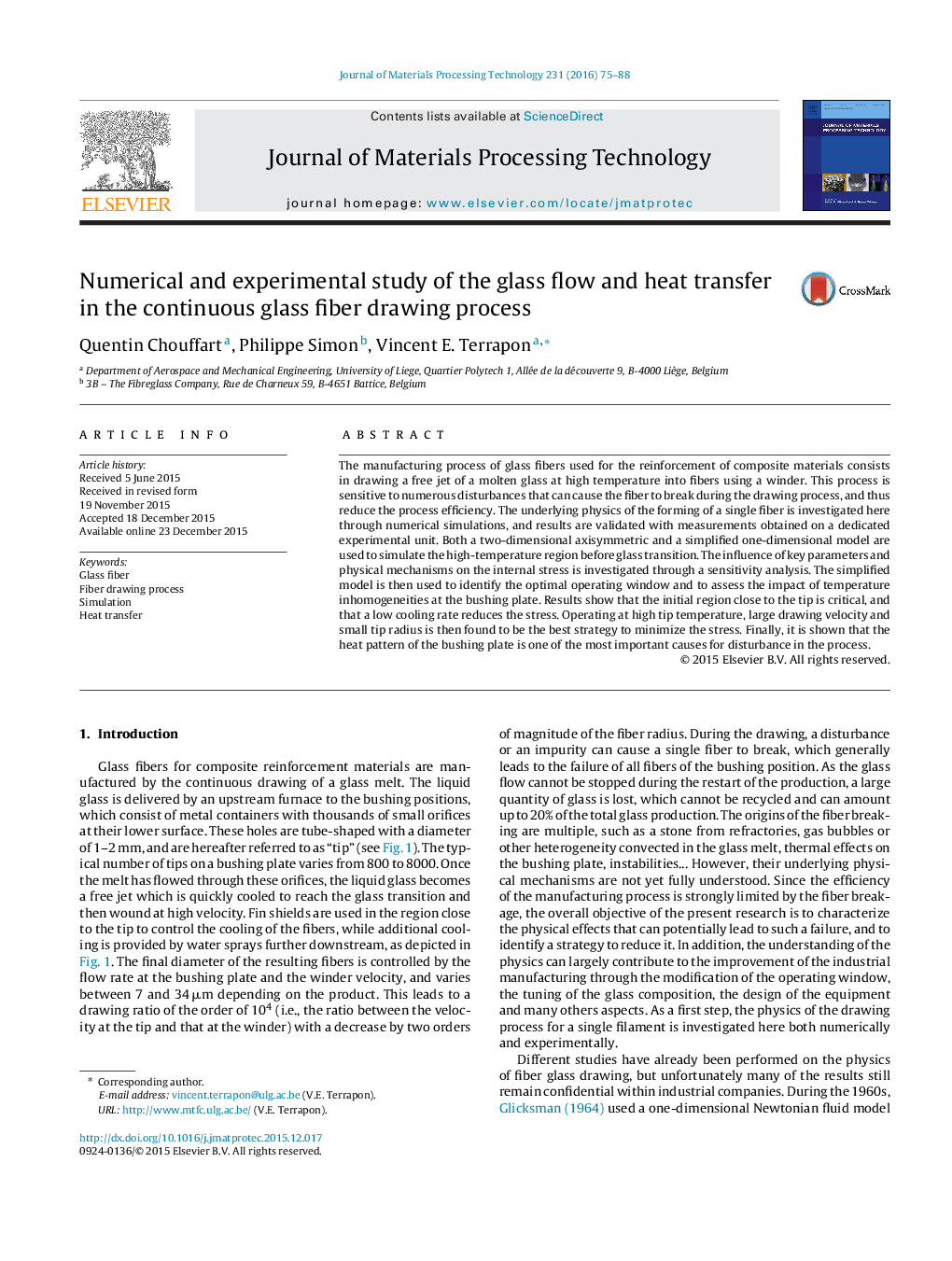| کد مقاله | کد نشریه | سال انتشار | مقاله انگلیسی | نسخه تمام متن |
|---|---|---|---|---|
| 7176734 | 1466736 | 2016 | 14 صفحه PDF | دانلود رایگان |
عنوان انگلیسی مقاله ISI
Numerical and experimental study of the glass flow and heat transfer in the continuous glass fiber drawing process
ترجمه فارسی عنوان
بررسی عددی و تجربی جریان شیشه و انتقال گرما در فرایند رسم فیبر شیشه ای مداوم
دانلود مقاله + سفارش ترجمه
دانلود مقاله ISI انگلیسی
رایگان برای ایرانیان
کلمات کلیدی
فیبر شیشه ای، روند طراحی فیبر، شبیه سازی، انتقال گرما،
ترجمه چکیده
روند تولید الیاف شیشه ای که برای تقویت مواد کامپوزیتی مورد استفاده قرار می گیرد شامل جت جت یک شیشه ی مذاب در دمای بالا به الیاف با استفاده از سیم پیچ است. این فرایند به اختلالات متعدد حساس است که می تواند در طی فرایند رسوب باعث شکستن فیبر شود و بنابراین کارایی پردازش را کاهش می دهد. فیزیک پایه تشکیل یک فیبر تک در اینجا از طریق شبیه سازی های عددی مورد بررسی قرار گرفته و نتایج با اندازه گیری هایی که در واحد آزمایشی اختصاص داده شده تایید می شوند. هر دو مدل محوری دو بعدی و یک بعدی یکپارچه، برای شبیه سازی منطقه درجه حرارت بالا قبل از انتقال شیشه استفاده می شود. تأثیر پارامترهای کلیدی و مکانیسم های فیزیکی بر استرس داخلی، از طریق تحلیل حساسیت بررسی می شود. سپس مدل ساده شده برای شناسایی پنجره عملیاتی مطلوب و برای ارزیابی تاثیر غیرموجیت های دما در صفحه بوشه استفاده می شود. نتایج نشان می دهد که منطقه اولیه نزدیک به نوک حیاتی است و میزان خنک کننده کم استرس را کاهش می دهد. در نتیجه، در دمای نهایی بالا، سرعت کشش بزرگ و شعاع نوک کوچک، بهترین راهکار برای به حداقل رساندن استرس است. در نهایت، نشان داده شده است که الگوی حرارت ورق بوش یکی از مهمترین دلایل ایجاد اختلال در روند است.
موضوعات مرتبط
مهندسی و علوم پایه
سایر رشته های مهندسی
مهندسی صنعتی و تولید
چکیده انگلیسی
The manufacturing process of glass fibers used for the reinforcement of composite materials consists in drawing a free jet of a molten glass at high temperature into fibers using a winder. This process is sensitive to numerous disturbances that can cause the fiber to break during the drawing process, and thus reduce the process efficiency. The underlying physics of the forming of a single fiber is investigated here through numerical simulations, and results are validated with measurements obtained on a dedicated experimental unit. Both a two-dimensional axisymmetric and a simplified one-dimensional model are used to simulate the high-temperature region before glass transition. The influence of key parameters and physical mechanisms on the internal stress is investigated through a sensitivity analysis. The simplified model is then used to identify the optimal operating window and to assess the impact of temperature inhomogeneities at the bushing plate. Results show that the initial region close to the tip is critical, and that a low cooling rate reduces the stress. Operating at high tip temperature, large drawing velocity and small tip radius is then found to be the best strategy to minimize the stress. Finally, it is shown that the heat pattern of the bushing plate is one of the most important causes for disturbance in the process.
ناشر
Database: Elsevier - ScienceDirect (ساینس دایرکت)
Journal: Journal of Materials Processing Technology - Volume 231, May 2016, Pages 75-88
Journal: Journal of Materials Processing Technology - Volume 231, May 2016, Pages 75-88
نویسندگان
Quentin Chouffart, Philippe Simon, Vincent E. Terrapon,
